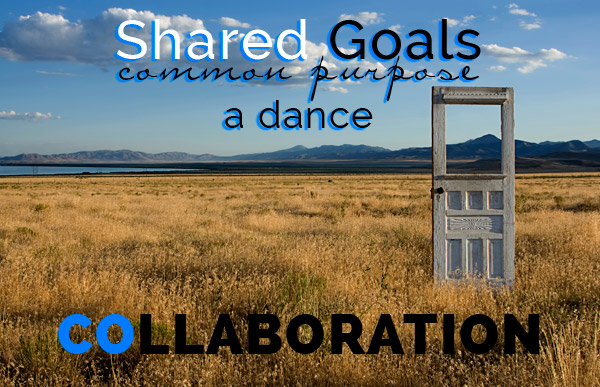Using Collaboration For Shared Goals
It’s A Dance We Do Together
Teaming Up
What is it about joining forces that makes it so seductive? It’s the inclusion, the opportunity to learn, expand beyond our current limits, the realization that we can gain strength in numbers; all contribute to its allure. We crave those things. It’s attractive to consider doing something better together than we can do on our own. We seek partners for living, for working, for playing because we understand this instinctually. We’re here together. Let’s make use of that. Even if we make the assumption that in some scenarios we’re competing, there is still benefit in collaboration.
Collaboration has a broad enough [application of] meaning to encompass a wide scope of instances where it may occur. When we look closely, we can see that we are employing bits of it just about everywhere and in most everything we do. So we are already good at it. There’s really no limit to how we might consider it to be part of the fabric of life and work.
“If you have an apple and I have an apple and we exchange these apples then you and I will still each have one apple. But if you have an idea and I have an idea and we exchange these ideas, then each of us will have two ideas.” – George Bernard Shaw
Google tells us that it’s “the action of working with someone to produce or create something.” I’ll add to that “…to create Something of value that we wouldn’t be able to otherwise”.
“Many ideas grow better when transplanted into another mind than the one where they sprang up.” – Oliver Wendell Holmes
Exponential Growth In A Pure And Basic Form
Collaboration and Cooperation are close cousins and the idea of them, their lingual representations, are often swapped because they are so intimately related.
[Tweet “Collaboration begets cooperation and cooperation brings life to collaboration.”]
Cooperation: an instance of acting together for a common purpose or benefit
That Something that collaboration “produces” may be a feeling, a verbal or relational exchange, a family system, a friendship and then we’re back to cooperation again. So we may as well wrap them together with some string and paper and let it sit like that.
How Can We Cull Opportunities?
Collaboration requires social sensitivity, good communication skills, a softening of ego and a capacity to tolerate uncertainty – the ability to wait and see what happens. There are those precarious moments when we’re unsure of our Collaborative Partner(s) or Cooperating Other(s). We recruit our patience and wait. It requires letting go of control. Reflection, awareness and negotiation. Sharing. Neuroscientists have proven there’s a reward circuit triggered in our brains when we cooperate- it feels good.
Naming Something
When we label or name it, we give ourselves the awareness towards being more open-minded, humble, to build our empathy. The messages that are coming in from another entity become more available to us. This is the foundation for a lot of our working processes. So obvious we forget to think about it.
“It is the long history of humankind (and animal kind, too) those who learned to collaborate and improvise most effectively have prevailed.” – Charles Darwin
“A knotty puzzle may hold a scientist up for a century, when it may be that a colleague has the solution already and is not even aware of the puzzle that it might solve.” – Isaac Asimov
Art Teaches Business : Business Teaches Art
Natalie Nixon, Director of the Strategic Design MBA at Philadelphia University and Principal of Figure 8 Thinking, LLC, lists 5 reasons why collaboration is needed for the growth of our businesses (abridged):
- Self-awareness. …Collaborating challenges you to articulate and distill what you are great at, and what you do poorly…
- Scale. …More effective problem solving happens when you combine resources in talent, experience, finances and infrastructure. … Understand that your firm is part of a greater whole, and that there is power in that.
- Creative Abrasion. …We typically associate friction with something negative, but friction in its purest form, is energy…
- Take the long view. Sometimes things don’t work out well when you collaborate with others, no matter how hard you try, how patient you are, and how well you listen. But … while an initial project may not do well, the partnership may still be salvageable.
- Learn, learn, and learn some more! Collaborating propels your firm to become a learning organization, a popular phrase right now that refers to organizations which have cultures of ongoing learning, and structures that support that learning through safety nets for failure… Each time your firm collaborates with others you optimize the capacity of your associates to extend beyond their comfort zone, grow, and in turn, stretch the boundaries of the organization.
This makes good business sense and there are other things we can learn by witnessing how collaboration functions across disciplines. Each of those five points can easily be applied to art and historically they have been. Art and business can inform each other- throw that ball back and forth to open channels between them. Set examples.
The avant-garde worldwide early 20th century artists and poets, Dadaists, leading a movement born of moral crisis at the beginning of First World War, believed that the value of art lay not in the work produced, but in the act of making and collaborating with others to create new visions of the world. Process. That premise is widely adopted and artists collaborate across disciplines frequently. Obviously, results matter in plenty of circumstances, particularly in business, but understanding the simple value of process brings us closer to a more elevated result or product.
Joining Of Forces Is Akin To A Dance
We create the sensitivity to another’s subtle moves and nuances in order to anticipate and know our next step. My own earliest experiences with collaboration were in the performing arts – in dance, drama and music studios as a young child in the form of group improvisations. Improv in a group builds a certain kind of vigilance to our surroundings and surrounding organisms. We learn the arts of noticing, inclusion, flexibility and adaptability.
[Tweet “Taking the cue from someone else fosters our inventiveness.”] It gives us courage to go to places we haven’t before.
We can listen to the fragments of the comments below (extracted from the video near the bottom) to begin imagining the complexity and the simplicity of a collaborative dance work and apply some of the same principles to business collaboration.
“…one of the kind of rules is to act on instinct. …7 bodies, 7 people making decisions moving in this incredibly complex multi-layered way ..so you have to be really aware of everyone around you…”
“…be able to improvise and discover possibility while still remaining loyal to the meticulous detail of the material.”
“…continually remind ourselves keep it simple….when things go awry keep it simple. The simplest point from A to B is from A to B.”
Is There A Downside?
The process of collaboration can also create a sense of threat for some because it necessitates a certain amount of vulnerability. Because we can’t truly collaborate productively without giving up a little something. There’s a compromise in the midst of the process- a need to allow another to take the lead, make room for give and take. It takes some practice to enable the necessary fluidity and acceptance for a true alliance.
At Aiim, The Global Community of Information Professionals collaboration at the conceptual level is described like this:
- Awareness – We become part of a working entity with a shared purpose
- Motivation – We drive to gain consensus in problem solving or development
- Self-synchronization – We decide as individuals when things need to happen
- Participation – We participate in collaboration and we expect others to participate
- Mediation – We negotiate and we collaborate together and find a middle point
- Reciprocity – We share and we expect sharing in return through reciprocity
- Reflection – We think and we consider alternatives
- Engagement – We proactively engage rather than wait and see
At every level of business we can gain from partnering, teaming up. We look at web development and design as a collaboration with our clients. (the exception being those who wish us to literally take matters into our own hands and grant us license to do so) We team up to create something we would not have were we not in connection and in common purpose with each other. Individually, we all bring who we are, our expertise and experience to the table. Together, we make a new thing. It functions to add to the elements that create success for both entities.
Synchronous and Asynchronous Collaboration
Some joint efforts happen in real time. Others do not. They travel through time and history to enhance something in the present. And in that manner, time can disappear.
Choreographer, Trisha Brown, made a dance in 1983 named “Set and Reset” and she and her company performed it at the Brooklyn Academy of Music. She collaborated with visual artist Robert Rauschenberg for the set and costume design, Beverly Emmons with Robert Rauschenberg for the lighting and performance artist and composer Laurie Anderson for the sound and music. Synchronous. (mostly)
Some twenty-eight years later, in 2011, the Trisha Brown Dance Company and the Candoco Dance Company collaborated in a restaging of the piece and created “Set and Reset/Reset”. A collaboration in the present and also across the years. Asynchronous. (mostly)
“The process of re-construction (as opposed to replication) is a negotiation between freedom and limit – an exploration of possibility as the dancers create a new version of Trisha Brown’s landmark choreography.” – Abigail Yager (Trisha Brown Dance Company)
”Former Trisha Brown Dance Company member Abigail Yager taught the Candoco Dance Company dancers exact sequences from the original choreography and later guided them in an extensive improvisation process whereby they used the same set of instructions that Brown gave to her Company in 1983: keep it simple, act on instinct, stay on the edge, work with visibility and invisibility, and get in line.” (YouTube description)
I found this to be a fascinating example. The original collaboration found new life in its creative collaborative process and organization of the original and the new.
[Trisha Brown Dance Company, Set and Reset 1983 – music by Laurie Anderson: “Long Time No See”, Set, Costumes, Lighting: Artist Robert Rauschenberg]
[Tweet “The vocabulary and the languages of art and business intersect when they inform each other. “]
Taking a look at collaborative projects in all disciplines can widen our view of what’s possible for business and our attitudes in working together.
ADDITIONAL RESOURCES
~ Video excerpt from the original performance
~ The restaging by Candoco Dance Company If you scroll down to the “Insight Video” (second video on this page), you will learn more about the specific process used to create the restaging. This one is my favorite but it wasn’t available for embedding.
~ Trisha Brown discusses Set and Reset on stage with dancers at Jacob’s Pillow, 1983
SUBSCRIBE & Receive Blog Notifications Of New Posts:
* Don’t miss any of our blog posts! Subscribe at the top right of this page.
Google Plus Post Notifications:
* Would you like to be included in my Google Plus Notification Circle?
If you would, please visit the invitation and let me know in the comments with a +mention of my name. Thanks!
Pre-remix image iStockPhoto
We’ve recently installed Google+ Comments.
If you’d like to leave a COMMENT- PLEASE CHOOSE:
‘W’ for our WordPress commenting system,’G+’ for Google+, or ‘F’ for Facebook






